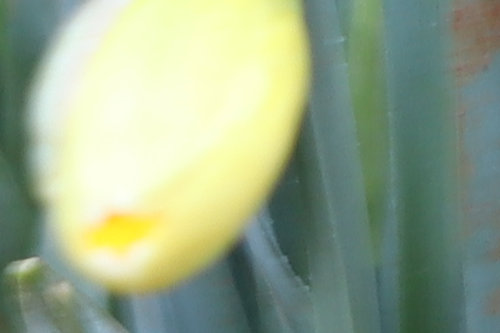Linking up with Rain's Thursday Art Date.
Thursday, January 27, 2022
Sunday, January 23, 2022
AYWMC: Part 1 Technical, Lesson 6: Metering
This post is part of a series entitled A Year With My Camera.
Lesson 1.6 in my own words:
-
Review
- The camera has 3 settings that control light: aperture, shutter speed, and ISO.
- Each has a creative effect or consequence.
- Practice: Throughout the year, repeat the exercises of the first 5 lessons
- Shoot on aperture and shutter priority modes.
- Look at shots taken on auto, and think how they could be better
- At least once a month, practice on manual mode
- Histogram: A bar chart showing light values.
- For each photograph taken, the camera counts the pixels, calculates how many of each tone there are, then plots them on a bar chart (histogram).
- Black tones are on the left.
- White tones are on the right
- Metering: When the camera measures how much light is falling on the scene.
-
The camera is programmed for a choice of three kinds of metering.
- Matrix, or evaluative metering (usually default) - The camera takes a broad reading from the entire frame. Can be skewed if, for example, the background is very light or dark compared to the subject.
- Center-weighted metering - Priority is given to whatever is in the middle of the frame. A good all-purpose setting.
- Spot metering - The photographer chooses one small area of the frame for a reading, usually one of the small rectangles seen in the viewfinder indicating where the camera is focused. This is the most accurate way of getting correct exposure.
- Metering will vary depending on the camera's mode.
- The histogram represents the metering for each potential picture.
- Exposure compensation
- An alternate way to correct exposure
- Quicker than adjusting shutter speed, aperture, or ISO.
- The camera's exposure compensation function lets you make changes without having to fiddle with the other settings.
- Represented as a scale from -3 to +3, with increments in full and third stops.
-
Can be used visually (eyeball it) or with the histogram.
- If the histogram shows underexposed, use exposure compensation to choose more light.
- If the histogram shows overexposed, choose less light.
This Week's Project:
- Select one of the auto modes and photograph a piece of white paper.
- Check the histogram. The camera will display it for mid-gray.
- Using manual mode or exposure compensation, adjust the histogram to display the paper as white, with the bars all the way to the right.
- Try other subjects, indoors and out, and observe the histogram.
Before tackling the homework, I first needed to find the exposure compensation function on my camera and experiment with it (because I'm not ready to try this on manual mode yet!)
 |
| Exposure compensation 0 |
 |
| Exposure compensation +1 |
 |
| Exposure compensation +2 |
 |
| Exposure compensation +3 |
 |
| Exposure compensation -1 |
 |
| Exposure compensation -2 |
 |
| Exposure compensation -3 |
Then it was on to the actual homework assignment, which was a repeat of lesson 1. We were to photograph white poster board so that it filled the entire camera frame. But this time, I used the camera's built-in histogram and corrected exposure so that my photo looked like what I saw.
There is no way to download the camera's histograms to illustrate the lesson, so I used my photo editor, Gimp. I took three photos; the first with the settings the camera chose, the second and third are my adjustments with exposure compensation. Then, I opened the photos in Gimp took screenshots of the histograms.
This first photo is as interpreted by the camera, which assumes a total exposure of mid-tone grey.
 |
| White poster board, as interpreted by the camera (see lesson 1 for explanation) |
Here's the histogram for the above photo.
 |
| The histogram shows that the camera interpreted it in middle tone greys. |
Second photo, trying to adjust the histogram with exposure compensation.
 |
| White poster board with exposure compensation +2. |
Here's the histogram for that photo.
 |
| The histogram is moved considerably toward white. |
One more try.
 |
| White poster board with exposure compensation +3. |
Here's how it looked on the histogram.
 |
| Basically, a thick white vertical line on the right of the graph. |
I'll experiment with this more over the next couple of days.
What I learned:
- Let's start with what I didn't learn. Even though the lesson was entitled "metering," I did nothing with the camera's built-in meter!
- I did learn how to find and use another of my camera's buttons (exposure compensation).
- I learned the basics of how to read a histogram.
- One of the points of the lesson is to compare what your eye sees with what the camera sees (via the view screen), and to adjust exposure so that the camera matches the eye. For example, if the subject is too light or too dark compared to the background, I now know how to correct it.
- If I change ISO manually, then I need to reset it to AUTO to give control back to the camera.
Thursday, January 20, 2022
Monday, January 17, 2022
AYWMC: Part 1 Technical, Lesson 5: The Exposure Triangle
This post is part of a series entitled A Year With My Camera.
Lesson 1.5 in my own words:
- Review
- On the auto modes (auto, program, aperture, and shutter priority), the camera determines exposure.
- The camera chooses the aperture, shutter speed, and ISO to produce an equivalent to an 18% mid-tone gray image.
- The camera isn't programmed for creative effects, and therefore never chooses extremes in aperture, shutter speed, and ISO.
- The exposure triangle
- Aperture, shutter speed, and ISO are the three corners of the triangle.
- If one goes up, the other two must go down to compensate and correct exposure.
- The camera does the compensating in any of the auto modes.
- Manual mode gives the photographer complete control of the camera.
- Understanding Stops
- Stops are measurements of the amount of light the camera lets in via aperture, shutter speed, and ISO.
- Each stop lets in the same amount of light. Example: 1 stop on the aperture scale corresponds to 1 stop on the shutter speed scale.
- Each change in stop doubles or halves the amount of light.
- The photographer can choose full, half, or third stops.
- Applying stops to the exposure triangle
- Example - If aperture is increased by two stops, then either shutter speed or ISO must be decreased by two stops. Or, both must be decreased by one stop each.
This week's project:
- Practice adjusting exposure settings but keep the overall exposure the same by applying the principles of the exposure triangle.
- Start with aperture priority mode.
- Choose a mid-range full aperture stop and take a photo
- Write down the three settings
- The aperture stop you chose
- The shutter speed and ISO the camera chose
- Change to manual mode
- Dial in the three settings you copied from the first photo
- Change the aperture stop to the next full wider aperture stop.
- Change the shutter speed one stop in the opposite direction (faster).
- Take a second photo. Both photos should have the same exposure.

|
| Av mode: I chose f/8.0. Camera chose 1/60th sec. and ISO 100 |

|
| Manual mode: f/7.1, 1/80th sec, ISO 100 |
- Try the same exercise with shutter speed.
- Change your camera to shutter priority.
- Choose a shutter speed between 1/60 & 1/250, and take a photo
- Write down the three settings
- The shutter speed you chose
- The aperture and ISO the camera chose
- Change to manual mode
- Dial in the three settings you copied from the photo.
- Change the shutter speed two full stops.
- Change aperture and ISO one stop each in the opposite direction.
- Take a second photo. Both photos should have the same exposure.

|
| Tv mode: I chose 1/100th sec. Camera chose f/16 and ISO 100. |

|
| Manual mode: 1/160th, f/18, and ISO 200. |
What I learned:
- That this was hard! Because:
- None of the numbers are intuitive yet, so "opposite" stumped me, as does "higher" and "lower.
- I haven't memorized full versus half or third stops, so I wasn't sure I was following the assignment by simply turning the dial.
- (I'm not entirely sure I adjusted the settings correctly.)
- But I did learn some things:
- How to adjust aperture, shutter speed, and ISO on manual mode
- How the exposure triangle works. (In other words, I got the lesson!)
- I'm also learning that I need a lot more practice with each lesson, so that I'm not having to stop and think for every adjustment.
Thursday, January 13, 2022
Sunday, January 9, 2022
AYWMC: Part 1 Technical, Lesson 4: ISO
This post is part of a series entitled A Year With My Camera.
Lesson 1.4 in my own words:
- ISO (International Standards Organisation) - a measure of sensitivity to light
- 1 of 3 options (along with aperture and shutter speed) to control the amount of light hitting the camera's sensor.
- Technical aspect: increasing ISO makes it easy to take photos in low light.
- Creative aspect: none
- Potential negative aspect: high ISO can degrade the quality of the photo.
- Changing ISO
- Auto ISO - lets the camera choose
- Manual ISO - check camera manual for instructions
- When to change ISO
- On manual shutter speed
- long shutter speed may require a lower ISO to darken the exposure
- fast shutter speed may require a higher ISO to lighten the exposure
- On manual aperture settings
- as depth of field increases (due to smaller aperture), more light is needed for proper exposure.
- increasing ISO is an alternative to lengthening shutter speed, which increases the risk of camera shake.
- Step 1
- Learn how to change your ISO manually.
- Find out if you have Auto ISO and in which modes it works.
- Step 2
- Choose either the aperture or shutter speed exercise from lessons 2 or 3, and experiment with the ISO for each.
- Don't worry about the quality of the photo (graininess/noise). The purpose of the exercise is to begin to understand ISO through experience.
I decided to try the homework on both aperture and shutter speed. I took these
photos at the largest resolution my camera offers (6000 pixels by 4000
pixels), which is way too large to display on this blog. So I resized them to
500 pixels by 333 pixels, to display the entire image. To get a closer
look at image quality, I also cropped a 500x333 selection from the original photo.
I started with aperture.

|
| Large aperture (f/5.0) and low ISO (100) |

|
| Same photo, clip from original size |

|
| Large aperture (f/5.0) and high ISO (25,600) |

|
| Same photo, clip from original size |

|
| Small aperture (f/32.0) and low ISO (100) |

|
| Same photo, clip from original size |

|
| Small aperture (f/32.0) and high ISO (25,600) |

|
| Same photo, clip from original size |
Then I took a second set with different shutter speeds.

|
| Short shutter speed (1/40 sec) and low ISO (100) |

|
| Same photo, clip from original size |

|
| Short shutter speed (1/40 sec) and high ISO (25600) |

|
| Same photo, clip from original size |

|
| Long shutter speed (1/4 sec) and low ISO (100) |

|
| Same photo, clip from original size |

|
| Long shutter speed (1/4 sec) and high ISO (25600) |

|
| Same photo, clip from original size |
What I learned:
- I could definitely see the point of the lesson, that photo quality degrades with higher ISOs.
- Since I manually controlled only two of the three things that affect exposure (aperture, shutter speed, and ISO), and the camera compensated by automatically adjusting the other one.
- That correct exposure is a complex task and will take a lot of practice to master (or at least get half-way decent at.)
- That my camera does a really good job compensating. (So, I'm not sure I got all the subpoints of the lesson).
- I won't have to worry much about ISO for any photo I publish on the internet. Graininess can't be seen after resizing them for online use, unless I crop like I did for this exercise.
- For print photos, I'll have to take more care to avoid grainy pictures.
Subscribe to:
Posts (Atom)









